#Trinidad and Tobago Painter
Explore tagged Tumblr posts
Text
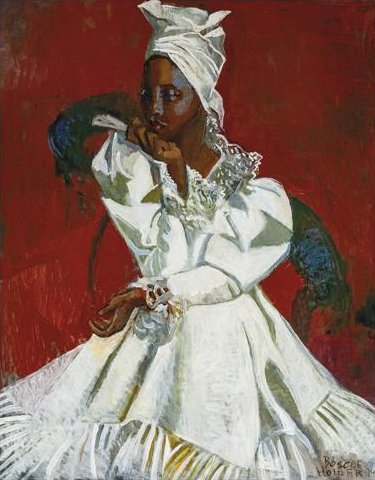
Girl with a Fan by Boscoe Holder
328 notes
·
View notes
Text

Sexypink - Brian Ashing - Paradise of Scorched Earth (30” x 30”) oil on canvas

Sexypink - The Legend Mick Jagger with his aquired Brian Ashing Paradise of Scorched Earth.

Sexypink - Brian Ashing - from his recent show Nature of Power.

Sexypink - Brian Ashing - Heart of Fire, Tongue of Embers- 20” x 16” - oil on linen
#sexypink/Trinidad and Tobago#sexypink/ Brian Ashing#sexypink/Brian Ashing#Mick Jagger#the rolling stones#Brian Ashing#tumblr/ oil painter
16 notes
·
View notes
Text
A Multidimensional Artist from around the Neighbourverse!
TheLoveWarrenShop is an enchanted marketplace that has a full gallery available for purchase. Also featuring Carmichael’s Workshop, stocked with pieces from his last moments - all proceeds go towards handling his estate.
COMMISSIONS ARE CURRENTLY CLOSED






#shesha_love_#thelovewarren#Carmichael’s workshop#toronto#painting#artist community#acrylic paint#black artist#fyp#black painters#trinidad and tobago#caribbean#caribbean art#caribbean artist#father daughter duo#canada#canadian#online shop#shop online#current wip
3 notes
·
View notes
Text







Christopher Ofili, (born 1968) is a British painter who is best known for his paintings incorporating elephant dung. He was Turner Prize-winner and one of the Young British Artists. Since 2005, Ofili has been living and working in Trinidad and Tobago, where he currently resides in the city of Port of Spain. He also has lived and worked in London and Brooklyn.[1]
Ofili has utilized resin, beads, oil paint, glitter, lumps of elephant dung and cut-outs from pornographic magazines as painting elements. His work has been classified as punk art.
11 notes
·
View notes
Text

SIR HORACE OVE (1936-Died September 16th 2023,at 86).Trinidad and Tobago-born British filmmaker, photographer, painter and writer based in London, England. One of the leading black independent filmmakers to emerge in Britain in the post-war period, Ové was the first black British filmmaker to direct a feature-length film, Pressure (1976). In its retrospective documentary, 100 Years of Cinema, the British Film Institute (BFI) declared: "Horace Ové is undoubtedly a pioneer in Black British history and his work provides a perspective on the Black experience in Britain."
Ové built a prolific and sometimes controversial career as a filmmaker, documenting racism and the Black Power movement in Britain over many decades through photography and in films such as Baldwin's Nigger (1968), Pressure, and Dream to Change the World (2003). Ové's documentaries, including Reggae (1971)[5] and Skateboard Kings (1978), have also become models for emerging filmmakers. He was awarded a knighthood in the 2022 New Year Honours for services to media.Horace Ové - Wikipedia
#Sir Horace Ove#British Film Directors#Film Directors#Pressure#British Civil Rights Activists#Civil Rights Activists#Notable Deaths in September 2023#Notable Deaths in 2023
2 notes
·
View notes
Text

Christopher Ofili, CBE (October 10, 1968) is a British Turner Prize-winning painter who is known for his paintings incorporating elephant dung. He was one of the Young British Artists. Since 2005, he has been living and working in Trinidad and Tobago, where he resides in Port of Spain. He lives and works in London and Brooklyn.
He has utilized resin, beads, oil paint, glitter, lumps of elephant dung, and cut-outs from porn magazines as painting elements. His work has been classified as “punk art.”
When he was eleven, his father left the family and moved back to Nigeria. He was for some years educated at St. Pius X High School for Boys, and then at Xaverian College in Victoria Park, Manchester. He completed a foundation course in art at Tameside College in Ashton-under-Lyne in Greater Manchester and studied in London, at the Chelsea School of Art and the Royal College of Art. In the autumn of 1992, he received a one-year exchange scholarship to Universität der Künste Berlin.
He visited Trinidad for the first time in 2000 when he was invited by an international art trust to attend a painting workshop in Port of Spain. He permanently moved to Trinidad in 2005. #africanhistory365 #africanexcellence
1 note
·
View note
Text

Sexypink - A huge loss to Trinidad and Tobago. Thank you Geoffrey for your vision, kindness and love.
..............................

Geoffrey's contribution to Art history. He was the definitive writer on Cazabon.
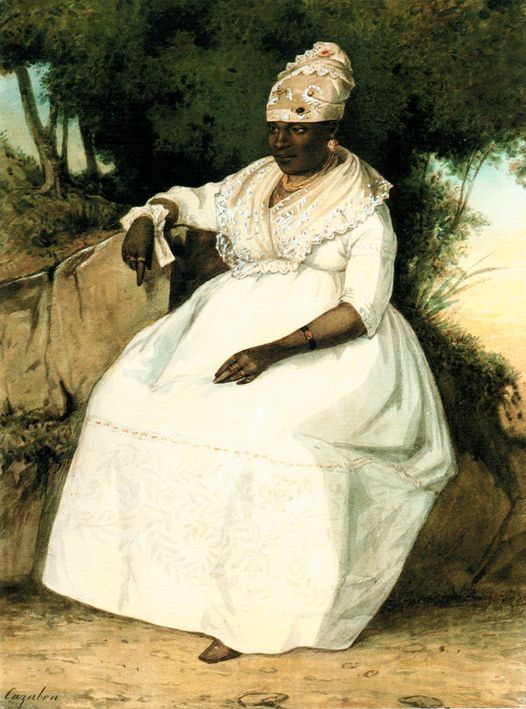
An image of one of Cazabon's paintings.
Finally, a beautiful tribute to Geoffrey MacLean from one of many friends.
.................................
TRIBUTE TO GEOFFREY MACLEAN. In each island nation of the Eastern Caribbean, economies of scale make it so that there are only one or two (and if they are lucky, three or four) local experts in some field of study which has little to do with industry or clerical work but everything to do with the national character and its history. Because they are often without precedent, these experts often have had to travel abroad for their training or are otherwise self-trained in their chosen sector of the liberal arts/humanities/social sciences.
Trained architect and avocational art historian Geoffrey MacLean was one of these indispensable sages in the field of visual studies and the built environment. He was the world’s foremost specialist on nineteenth-century landscape and genre painter Michel Jean Cazabon. Cazabon was a partially unwitting member of a global late colonial/early post-colonial landscape painting tradition that encompassed artists such as Mexican José María Velasco, the Chartrand brothers of Cuba, Filipino painter Fernando Amorsolo, and the painters of the Hudson River School in the United States. What all of these artists had in common was their urgent need to capture and pay tribute for posterity to the natural beauty of their respective lands before that “Edenic” verdure was despoiled by then-already encroaching industrialization.
MacLean’s passion for Cazabon pressed him not only to hone further the scholastic abilities he had already developed at Presentation College in his native Trinidad and Bristol University in the U.K. but to travel back and forth between the Caribbean and Europe hunting down examples and collections of Cazabon’s work. He also assisted the government of the Republic of Trinidad & Tobago in the acquisition of some Cazabon works for display in its National Museum and Art Gallery.
MacLean was generous with his knowledge, his time, and with his published materials. Every time I visited him, I came home with an armful of books and catalogues (one of my favorites is an unassuming little pamphlet of a catalogue called Chinese Artists of Trinidad & Tobago which probably played some part in my decision to write the book about Sybil Atteck on which I am currently working with Sybil’s nephew Keith). In graduate school, I relied heavily on MacLean’s Cazabon books for the research I was doing on colonial Latin American and Caribbean painting. MacLean’s enthusiasm for Cazabon’s genre painting, especially his rapt verbal and written descriptions of the late 19th century painting Negress in Gala Dress (pictured here) revealed to me that Cazabon’s paintings of local “types” (e.g., “Negress” instead of named individual) was sometimes a form of real portraiture and thus departed the tipo de país-to-costumbrismo continuum that we sometimes use in Latin American art history. Cazabon loved his people too much and included too much implied biography and other narratives in those paintings, to reduce their subjects to mere “types.” His titles were thus deceptively taxonomic.
Architect, scholar, art gallery director Geoffrey MacLean’s contribution to the study and preservation of T&T’s architecture was legendary even before his passing. He has searched out original plans for fretwork houses and saved some of these architectural jewels from the bulldozers of “developers.” He has done the same for members of the Magnificent Seven around the Queen’s Park Savannah and taught workshops on both the civic and residential architecture of Trinidad & Tobago. As MacLean himself now passes into legend, we are left with the perennial question in these small and mid-sized islands of the Eastern Caribbean each with their two or three experts on local art and architecture – who will pick up the torch?
~ Lawrence Waldron
#galleryyuhself/Geoffrey MacLean#galleryyuhself/publisher/gallery owner/architect#galleryyuhself/bereavement#galleryyuhself/medulla gallery#tumblr/aquarella gallery#tumblr/cazabon books#tumblr/architect#trinidad and tobago#Geoffrey MacLean#architect#visionary#gallery owner
0 notes
Text

Regarded as Trinidad’s first great painter, Michel-Jean Cazabon was born 210 years ago on Corinth Estate in Naparima, San Fernando on this day in 1813. He became famous internationally as an artist who was renowned for his paintings of Trinidad’s sceneries, as well as his portraits of planters, merchants, and the working class during the 19th century.
Cazabon's paintings are to be cherished not only for their beauty, but also for their historical importance, as his paintings have left us with a clear picture of what many aspects of life was like in Trinidad throughout much of the 19th century. His detailed depictions of everyday life are significant for showcasing an untouched Trinidad, before the age of heavy industrialisation during the 20th century.
Additionally, he chose formerly enslaved persons and indentured immigrants as subjects for his portraits, from the plains of Caroni and the tropical forests of Chaguaramas; a unique decision during that time to not choose the wealthy colonial authorities instead.
Cazabon came from a family of “free coloured” immigrants from Martinique who migrated to Trinidad following the Cedula of Population of 1783, and this may have influenced the topics he chose to depict in his art.
He was sent to Paris during the 1830s to study medicine, but instead focused on art and studied under the master painter Paul Delaroche. His pieces were exhibited at the Louvre Museum in Paris and in many galleries throughout Italy and the United Kingdom. He subsequently settled at home in Trinidad where he taught art, and Lord Harris - Governor from 1848 to 1854 - became his patron and collected many of his pieces before Cazabon’s passing in 1888.
This photo showing a drawing of Corbeaux Town, Port of Spain by M J. Cazabon is courtesy of the book “Album of Trinidad: From Drawings by M. J. Cazabon”, which is part of the National Archives of Trinidad and Tobago Special Collection.
References: Cazabon, Michel J. Album of Trinidad 1857. M.N. Pereira, 2002.
#micheljeancazabon #cazabon #nationalarchivestt #nationalarchives #knowyourhistory #trinidadandtobago #caribbeanhistory #westindianhistory
0 notes
Text
Studio Project 2: Self-Directed Research
Artist Research
Francesco Clemente
Often classified as a Neo-Expressionist, Francesco Clemente makes rich gouache paintings and pastel drawings that range from distorted portraits to dreamlike scenes of violence and eroticism. Throughout his strange figurations, Clemente depicts corporeal details such as mutilated limbs, floating eyes, and intertwined bodies with a surrealistic detachment and sense of sublime symbology: Clemente, who splits his time between New York and Varanasi, India, is particularly inspired by Indian mysticism, art, and culture. The artist has exhibited in New York, Milan, Rome, London, Amsterdam, Madrid, and Zürich. Clemente’s work has sold for up to six figures on the secondary market and belongs in the collections of the Art Institute of Chicago, the Centre Pompidou, the Guggenheim Museum, the Metropolitan Museum of Art, the Museum of Modern Art, the Rubell Museum, the Stedelijk Museum, and the Tate.
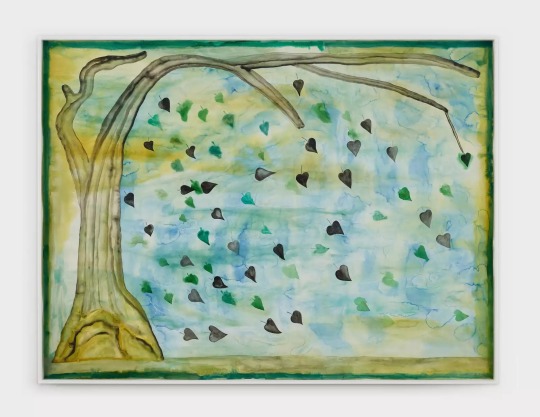
Air, 2021
Watercolor on paper
60 × 80 in | 152.4 × 203.2 cm
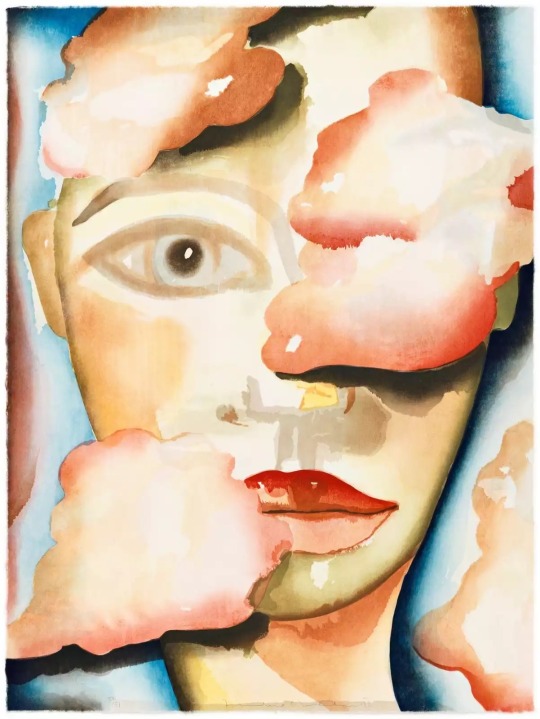
Air, 2007
Twenty-seven color Ukiyo-e woodcut hand-printed from 21 woodblocks
24 × 18 in | 61 × 45.7 cm
Edition 1/51
Inka Essenhigh
Inka Essenhigh (b. 1969, Bellefonte, PA) received her Master of Fine Arts from School of Visual Arts, New York, NY and her Bachelor of Fine Arts from Columbus College of Art & Design, Columbus, OH.

Inka Essenhigh, "Bleeding Hearts" (2021), Enamel on semi-rigid canvas, 121.9 x 96.5 cm, 48 x 38 in
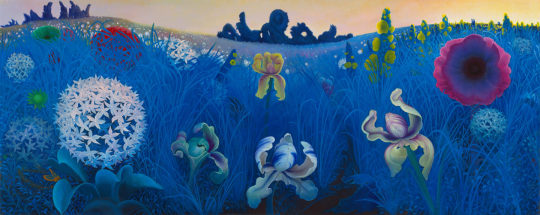
Inka Essenhigh, Blue Field, 2021
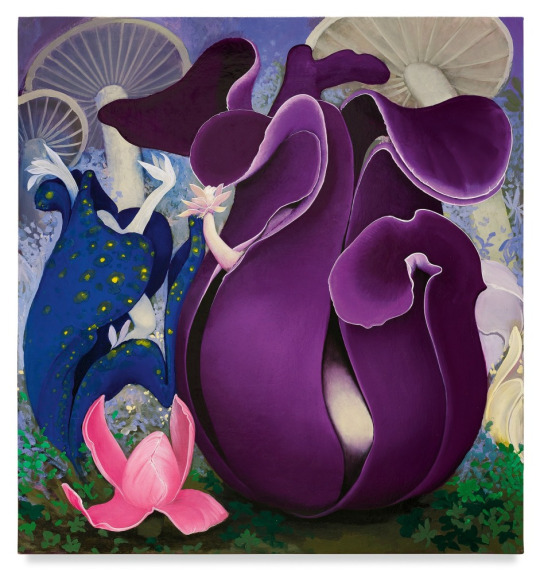
Inka Essenhigh, Purple Pods, 2019, Enamel on canvas, 34 x 32 inches
She paints a fluid, dreamy, fantasy landscape of animated, human-like trees and biomorphic beings – almost always women – veering towards a narrative art.
Chris Ofili
Introduction Christopher Ofili, (born 10 October 1968) is a British painter who is best known for his paintings incorporating elephant dung. He was Turner Prize-winner and one of the Young British Artists. Since 2005, Ofili has been living and working in Trinidad and Tobago, where he currently resides in the city of Port of Spain. He also has lived and worked in London and Brooklyn. Ofili has utilized resin, beads, oil paint, glitter, lumps of elephant dung and cut-outs from pornographic magazines as painting elements. His work has been classified as "punk art." WikidataQ1077608

Chris Ofili, The Great Beauty, 2020-2023, oil and charcoal on linen, 200 x 310 cm, 78 3:4 x 122 in © Chris Ofili. Courtesy the artist and Victoria Miro
"The Seven Deadly Sins are paintings in constant transition: between surface and depth, figure and foliage, light and dark; between mythology and religion, the sacred and profane."
"Nicholas Serota, who recently retired from his twenty-nine-year reign at the Tate, told me that Doig’s paintings “have a kind of mythic quality that’s both ancient and very, very modern. They seem to capture a contemporary sense of anxiety and melancholy and uncertainty. Lately, he’s gone more toward the sort of darkness we associate with Goya.”
"Ornamentation and visual excess have always featured in Ofili’s art"

Almost medieval … Chris Ofili, Requiem, 2023 (detail) commissioned for Tate Britain’s north staircase. Photograph: Thierry Bal/© Chris Ofili. Courtesy the artist
Emily Eleveth
Emily Eveleth is widely known for her paintings of jelly doughnuts. In fact, The Boston Globe wrote about this fascination in a 2008 article called “It’s time to paint the doughnuts.” She has had over 20 solo shows in museums and galleries on the East Coast, and received masters’ degrees from Smith College and the Massachusetts College of Art.
Spanning the boundaries between portrait, landscape, and object of projected desire, Emily Eveleth’s paintings form a genre unto themselves. Her ongoing series of paintings of doughnuts invests this unlikely subject with unexpected presence and identity. "Eveleth's paintings restlessly shift across a spectrum of meanings, covering along the way all the distances between opposing significances; prosaic and profound, profane and sacred, banal and intriguing, to say nothing of the axis between cool asexuality and gushing, if veiled, sexuality." *
In her concurrent series of figurative images lone figures stand in enigmatic isolation. Lost in private worlds the figures "seem to invite the viewer's gaze, acknowledge it, and then absorb it, folding it into their own particular dramas." ** These figurative projections of doubt and uncertainty appear paradoxical to their central declarative placement and openness. The dramatic lighting's interdependence on the rich enveloping darkness allows the figures to simultaneously emerge from and be enveloped by the inky space, projecting a quiet vulnerability.
Rashid Johnson
My works for the self-directed project depict a series of nightmares stemming from pain, anxiety, trauma, and several other mental health disorders. With the use of Vanitas Symbolism – the kind of painting that was popularised in the 17th century, often featuring still-life arrangements, including fruits, flowers, and other objects as symbols of the transience of life and the inevitability of death, I incorporate symbols of decay, such as wilting flowers or rotting fruits to convey the idea that even the most beautiful and vibrant aspects of life are subject to decay and eventual demise, suggesting a connection to human anguish and the fragility of existence. Moreover, I place decaying or withering fruits or flowers alongside depictions of human suffering or anguish to create a parallel between the ephemeral beauty of nature and the transient nature of human existence. The alignment between the fragile blooms and the sombre or distressed subject matter can evoke feelings of sorrow, mortality, or the fleeting nature of happiness. Plus, fruits and flowers are used metaphorically to represent human emotions and experiences. The work depicting a wilting flower or a bruised fruit symbolises a person's fading or wounded spirit undergoing emotional distress or pain. Similarly, an arrangement of fruits cut open or damaged serves as a metaphor for a human subject's inner turmoil or vulnerability. In terms of the colour palette, the one chosen for the fruits and flowers in a painting contributes to the depiction of human anguish. Dark, muted, or desaturated colours are used to represent sadness, despair, or suffering, while various parts are depicted with sharp contrasts between vibrant and sombre hues can create a sense of tension or conflict.
Georgia O'Keeffe: Known for her large-scale close-up floral paintings, Georgia O'Keeffe often explored the sensual and symbolic qualities of flowers. While her works are not explicitly focused on human suffering, they often evoke a sense of introspection, vulnerability, and emotional depth. Her magnified flower paintings, such as "Black Iris" or "Calla Lily Series," can be interpreted as metaphors for the human experience, including anguish and desire.

Mind Vomit
‘This represents the daily conversation within my mind. Anxious thoughts, depressive thoughts, sub-thoughts, thoughts about the thoughts, a constant critical commentary and a tornado of darkness, numbness and complete inner turmoil.’
Goya’s disasters of War
Jake & Dinos Chapman
destroyed bodies | Otto Dix
George Grosz
0 notes
Text
S E X Y P I N K

Michel Jean Cazabon
« French Negress in gala dress »
#sexypink/Michel Jean Cazabon#sexypink/painting#sexypink/Art History#sexypink/Trinidad and Tobago#tumblr/Michel Jean Cazabon#tumblr/painters#history#early painters in the Caribbean#Michel Jean Cazabon#negress#woman of colour#19th century painters of color#first great Trinidad Painter#Caribbean Painters of the 1800's
21 notes
·
View notes
Photo






NBA Clash - NBA Lootbag
Last year, I had the honour of working on my first game asset project. I was brought on by CodedArts Ltd - a local boutique, external development and video game studio based in my home country of Trinidad and Tobago- and commissioned to create an asset for the Android mobile game: NBA Clash by Nifty Games.
My assigned asset was a lootbag that was featured in game (See NBA Clash - Gamplay) . I was given concept art provided by Nifty and tasked to create two versions of the bag - one open and one closed with a total polycount of 6k tris for both assets.

I was mainly responsible for modeling and texturing the final assets. As mentioned, this was my first time working on a game asset; especially coming off of graduating from Animschool where I primarily learned how to model for animation.
Believe it or not, 3D modeling for animation versus 3D modeling for games is its own different approach despite sharing similar tools and process, as I soon learnt.
But for the most part, I had a positive experience working on this project. Although short (since I only worked on the asset for about a month), I learnt quite a lot about the game asset production process—a feat which influenced me to pursuing a career in the field full-time.
Big shout out to the CodedArts team for inviting me to work on this project.
And special thanks to Alex Jadoo (3D Craft Specialist) and Darnell Bruce (Technical Artist) who guided me through working on the asset alongside Caiphus Moore (Creative Director) who provided feedback and support.
—
Tools Used: Maya 2020.4 | Substance Painter | Marmoset Toolbag
—
~SC (2022)
6 notes
·
View notes
Text


Sexypink - Out of the blocks for 2024. What a delight that a book begins the year.
From Dr Marsha Pearce's Facebook page...
I am happy to announce the release of Black Light Void: Dark Visions of the Caribbean. The book is an edited collection of paintings by Trinidadian artist Edward Bowen and six short-story responses to Bowen's work, written by Trinidadian award-winning writers Kevin Jared Hosein, Barbara Jenkins, Sharon Millar, Amílcar Presi Sanatan, Portia Subran and Elizabeth Walcott-Hackshaw.
As Editor, Dr Marsha Pearce states...
With this book project, I ask: What stories lie beyond those experiences lit up by the sun–the light that is a defining feature of the tropics?

#sexypink/Dr Marsha Pearce#sexypink/Black Light Void: Dark Visions of the Caribbean#sexypink/Edward Bowen#sexypink/Painter Edward Bowen#sexypink/Trinidad and Tobago#tumblr/Art books#tumblr/Edward Bowen#tumblr/Dr Marsha Pearce#Dr Marsha Pearce#Black Light Void: Dark Visions of the Caribbean#paintings#collection of paintings by Edward Bowen#book projects#edited by Dr Marsha Pearce
5 notes
·
View notes
Photo

Agostino Brunias - Carib natives -
The Island Caribs, also known as the Kalinago or simply Caribs, are an indigenous people of the Lesser Antilles in the Caribbean. They may have been related to the Mainland Caribs (Kalina) of South America, but they spoke an unrelated language known as Island Carib. They also spoke a pidgin language associated with the Mainland Caribs.
At the time of Spanish contact, the Kalinagos were one of the dominant groups in the Caribbean, which owes its name to them. They lived throughout northeastern South America, Trinidad and Tobago, Barbados, the Windward Islands, Dominica, and possibly the southern Leeward Islands. Historically, it was thought their ancestors were mainland Caribs who had conquered the islands from their previous inhabitants, the Igneri. However, linguistic and archaeological evidence contradicts the notion of a mass emigration and conquest; the Island Carib language appears not to have been Cariban, but like that of their neighbors, the Taíno. Irving Rouse and others suggest that a smaller group of mainland Caribs conquered the islands without displacing their inhabitants, eventually adopting the local language but retaining their traditions of a South American origin.
In the early colonial period, the Caribs had a reputation as warriors who raided neighboring islands. According to the Spanish conquistadors, the Carib Indians were cannibals who regularly ate roasted human flesh. However, there are debates as to whether they were cannibals. Some claim there is evidence as to the taking of human trophies and the ritual cannibalism of war captives among both Carib and other Amerindian groups such as the Arawak and Tupinamba. Others argue Europeans misunderstood rituals, or falsely portrayed them to justify conquest and genocide. Today, the Caribs and their descendants continue to live in the Antilles, notably on the island of Dominica. The Garifuna or "Black Caribs", a group of mixed Carib, Arawak and African ancestry, also live principally in Central America.
Agostino Brunias (c. 1730 – April 2, 1796) was a London-based Italian painter from Rome. Strongly associated with West Indian art, he left England at the height of his career to chronicle Dominica and the neighboring islands of the West Indies. Painted in the tradition of vérité ethnographique, his art was as escapist as it was romantic.
35 notes
·
View notes
Text

Chris Ofili (British, b 1968) - Pramnian Odyssey I (2003-2011).
Christopher Ofili, CBE is a British Turner Prize-winning painter who is best known for his paintings incorporating elephant dung. He was one of the Young British Artists. Since 2005, Ofili has been living and working in Trinidad and Tobago, where he currently resides in Port of Spain.
7 notes
·
View notes
Text
Ava & Gabriel: A Love Story (1990)
Ava & Gabriel - Un historia di amor (original title)

Directed by Felix de Rooy
1h 40min | Drama
Setting: Willemstad, Curaçao, Netherlands
Producing Country: Netherlands | France | Netherlands Antilles
Language: Dutch | Papiamento
Period: Post Classical
TOMATOMETER Critics “certified fresh” score of NA
Description: In 1940s Curaçao, Gabriel Goedbloed, a charismatic painter, arrives from Holland to paint a mural of the Virgin Mary in St Anna’s Church, under the request of its parish priest. The colonial Antillean society proves less than tolerant towards the visitor, especially after he chooses Ava—a young, mixed-race teacher, who is engaged to be married, as his model for the Virgin Mary. | The trinidad+tobago film festiva
My Rating/Comment: Recommend | Set in Curacao in the 1940s, Ava & Gabriel: A Love Story provides an interesting twist on a communities struggle with racism and intolerance. The director Felix De Rooy was born in Curaçao, the Dutch Antilles, educated in The Hague, Netherlands and received a Master in Film from New York University. This gives him a multicultural view of the ways different cultures see and represent each other,
Awards (Wins and Nominations)
IMDb Link: Ava & Gabriel: A Love Story
2 notes
·
View notes
Photo

Happy Birthday Geoffrey Holder!!! Trinidadian born, Actor, Choreographer, Dancer, Painter, Singer, Tony Award–winning Stage Director!!! Today we celebrate you!! #GeofferyHolder . . . #Islandpeeps #islandpeepsbirthdays #jamesbond #annie #punjab #RIP August 20, 1930 - October 5, 2014 (at Saint James, Port-Of-Spain, Trinidad And Tobago)
7 notes
·
View notes